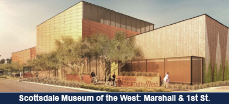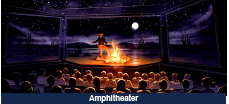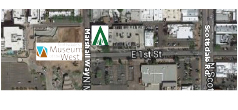An Interview with Mike Fox, CEO of Scottsdale Museum of the West
January 21, 2015
Article Written By: Tricia Covert
There are many Valley attractions the real estate community can highlight for visitors and residents that bring out the advantages of living in our beautiful city – the culture scene has become one of those attractions. With our Scottsdale campus situated in the Old Town Art District, I have the pleasure of viewing hundreds of people enjoying our culture daily, particularly during Thursday evening Art Walks. As of January 15, the Valley now has a valuable addition to our culture scene that is expected to gain national and international attention – Scottsdale Museum of the West.
Mike Fox is the Director responsible for leading many, major cultural projects in the Valley over the past several decades – he’s currently the Director of Scottsdale Museum of the West. I talked to Mike about the museum and it was very exciting to hear how this innovative institution was designed to be an entertainment destination that will have a positive impact on the quality of life for our community, Scottsdale businesses and for our out-of-town visitors.
Mike, can you tell me about yourself and your background?
I originally moved to Arizona from Wisconsin in 1971. I’ve been in the nonprofit business all of my adult life. First, I became Assistant Director of the Phoenix Art Museum and subsequently the Assistant Director of the Heard Museum for 13 years. I moved to Berkeley and worked with the University before I transitioned to the Museum of Northern Arizona in Flagstaff. The Flagstaff project was a $30 to $40 million initiative.
After 7 years in Flagstaff, I moved to Louisville, KY where I was the Director for the Mahammad Ali Center. We developed that project from merely a no concept, took Mahammad’s dream and built what he envisioned to be an extension of himself and his legacy. It’s a beautiful 98,000 square foot complex that totaled $110 million. After 7 years in Louisville, I moved back to the Valley to support this dream for the Scottsdale Museum of the West.
How did the concept for the Scottsdale Museum of the West begin?
It’s really a dream from Herb Drinkwater. Herb was an extraordinary man. Coincidently, when I was the Director of the Heard Museum in 198__ he had the vision for this museum. On occasion, he would come by on his jeep and pick me up to travel north, which at the time was anything north of Shea Blvd. – it was raw desert. We would drive around because he was thinking the museum would be near Rawhide for synergy purposes. Back then, Mayor Drinkwater identified a group of individuals to support the project and I was included in that group.
From that time forward, the City of Scottsdale had numerous iterations for the project over the years. In 2007, a handful of individuals formed this non-for-profit entity, Scottsdale Museum of the West. I then came in to help the group take the concept and get to where we are today. Interestingly, the same group of people that Mayor Drinkwater formed 30+ years ago are leaders of this project today (those who are still living.)
Who is the owner of the museum and what was the total cost of the project?
The City of Scottsdale owns the building “shell”– we, Scottsdale Museum of the West, are the managing operator of the facility – we’re responsible for the interior tenant improvements and of course the exhibits, interactives, visitor experiences and other dimension of the museum. Construction of the building invested by the City is $13.2 million and that does not include the public underground parking completed it was built. The interior is about $3 million – we also receive gratis or donations for various products from national or local entities.
With the vision in place for more than 30 years, what was the reason the project is moving forward now?
For the past 7 years, the hold off has mainly been the economy. Prior to that, the vision was not coming to fruition for various reasons: a certain art collection was not available, approval for the site wasn’t happening, etc. But, the group who are mostly long-time Arizona residents if not life-time Arizona residents, kept it alive because they always felt this subject area of the West was the void that was missing – for residents of the Valley and the visitors that come here each year.
The Visitors Convention Bureau conducts interviews and studies to find out how the average 8 million out-of-town visitors are enjoying their stay in Scottsdale. For a number of years, the ratings have been high in terms of people’s overall enjoyment here – the one evident thing that was missing according to visitors, was a lack of connection to the west – that feedback was good justification to move the project forward for the City of Scottsdale.
When was the museum project officially approved by the City of Scottsdale?
In February of 2013, the City of Scottsdale Council voted unanimously. I think the City was looking for an iconic draw that would fill the void identified. It was also time to implement a major entity for the Scottsdale community after the recession – we’re a thriving city rising out of the ashes, so to speak – the Council has great confidence in our future. The intention is to attract more people to our beautiful city and help support local businesses in Scottsdale. It’s a very, very important tourism destination, both nationally and internationally
We were very was pleased when the project was approved – the dream of giving Arizona residents and those 8 million visitors a way to connect to the region and really understand its historic and contemporary posture is going to be fulfilled. Everyone involved in this project believes that a museum, as different as this place is to be, will be beneficial. Now, it becomes our responsibility to ensure local residents and those 8 million visitors experience the west.
Can you tell me about the building itself and how the design and layout was derived? It looks very specialized.
The building is 43,000 square feet – what we’ve designed is going to be a LEEDs Gold standard building, that’s the highest exemplary that we can have that will show our responsibility to our environment.
Studio Balm is the architect of record for this project – a smaller firm with the husband and wife as the Principals. They were wanting this building to incorporate the design and material elements to reflect our mission. All the materials selected are indigent or ecologically sensitive to our surroundings. The ridges of the building mimic a saguaro cactus, the metal is going to intentionally rust causing the building to look more rustic – similar to a barn. In the courtyard, we have a barn door that is hung there for reinforcing that aesthetic.
The renderings on your website highlight more than a traditional museum that showcases art. What can people expect when they visit the museum?
The niche we’re trying to fill is to be a storytelling institution that entertains. We took the mission and created the vision to be more than a traditional museum. It is wonderful to look at paintings and sculptures and interrupt meaning. Our mission is to get people to greater appreciate what that image reflects in terms of time, circumstances and the story through engagement. There are a variety of ways that we’ll meet that objective: the kinds of media we’ve created, the interactive technology components installed in the facility for public participation and the programming that we have planned for the community such as festivals and special events.
We’ve conducted numerous focus groups and other kinds of engagement with the public. Particularity with the younger generation, such as the millennials, who are not typically museum goers today. We aren’t comprising anything to say it’s a place to have some fun. We’ve learned from our students the younger generations need to be stimulated – and we’re going to do that. The way we’ve always looked at this is we’re sort of the western anchor to the Old Town art district. Being that, we want to utilize the outdoor areas, the AmpaTheater and Ramada. I envision performing arts, poetry reading and various groups to gather here.
What type of visitors are you expecting to attract and how many each year?
We intentionally developed the museum to support a multi-generational community – from grandparents to their grandchildren. Younger generations tend to have a minimal connection to the place in which they live. We are making it a place where everyone wants to spend time. We plan to have regional, national and international conferences in different subject matters.
We’ve done our own studies – prior to the February 2013 approval to confirm what we’ve learned from the marketplace. Our projections expect about 100,000 visitors each year – that’s a very conservative. If we do our job about getting the word out, we should have many more visitors than that projection.
Where is your inventory of art coming from?
An interesting dimension, unlike any other museum, is we do not have our own collection. We are on the receiving end of those we reach out to loan us their collections. We have cultivated a number of collectors here and from outside of this region who have the very best of western art. For the first inaugural we have a national representation. The private collectors or institutions we are getting our artwork from have very important pieces and we’re thankful. We have an extraordinary collection of historic and contemporary collections.
We’re very happy to be your neighbor. How will Scottsdale Museum of the West interact with the surrounding Old Town community?
We’re going to be working with the galleries in the neighborhood. I would like to hold festivals and other community events that would be very participatory and collaborative of the galleries in the Scottsdale Old Town area. We hope that our existence here will enhance the business opportunities for the gallery owners that survived the recession. We’ve lost a lot of gallery owners during these hard times and we hope to support the entities that are in business today. We intentionally did not build a café in our museum to support the local, smaller restaurants in the area as well. We will encourage private use of the facility by leasing out space which we hope will be catered by local restaurants. We want it to be a win-win for everyone.
How should the real estate community view this new Scottsdale initiative?
I would like the REALTORS of our community to be exposed to the museum themselves to truly gain an understanding of the value it brings to the Valley. This is something that they will definitely want to mention to their clients and include as a Valley feature. The facility is meant to improve the quality of living for residents here.
Contact Marketing Communications Director – Alan DePerna
To think that this process in a sense has taken 30 years to come out of the ground and to think the leadership team had persevered and haven’t lost their commitment of community of consciousness – that’s really an interesting dimension in itself.
Please check our website at www.asreb.com for an update and attend our seminar, The Emerging Global Market on February 27, 9:00am to 12:30pm at our Scottsdale campus to hear Mike Fox talk about further plans with the museum as well as special features and promotions.
REGISTER FOR SEMINAR HERE
 Tricia Covert is the Marketing Manager for the Arizona School of Real Estate & Business. She has more than fifteen years of marketing experience working in various industries at a corporate and small business level.
Tricia Covert is the Marketing Manager for the Arizona School of Real Estate & Business. She has more than fifteen years of marketing experience working in various industries at a corporate and small business level.






